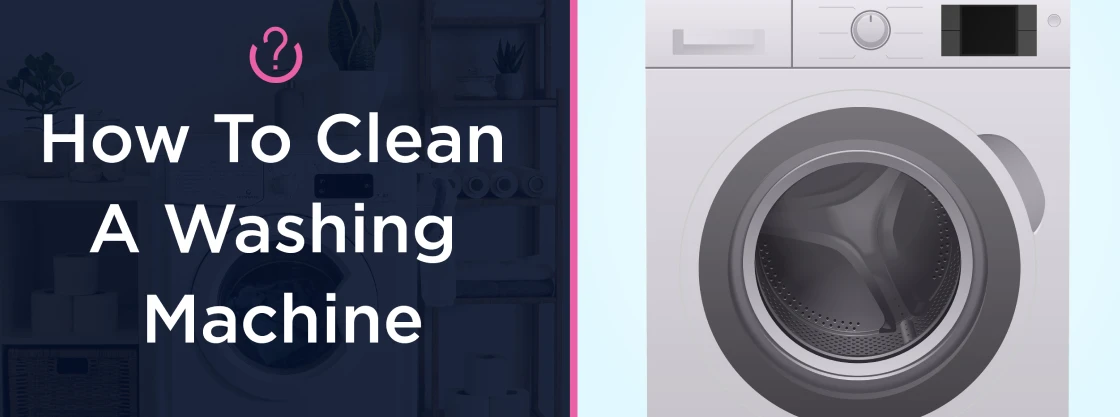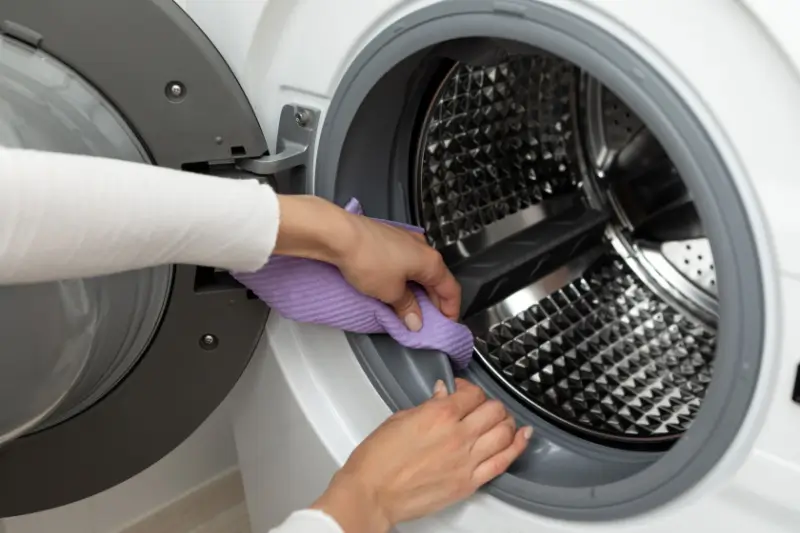
Last Updated: May 2, 2024
We don’t give much thought to the modern marvels that are washing machines. They remove stains, dirt, and bacteria while requiring little ongoing maintenance. Over time, dirt and detergent are bound to build up in your machine. Putting your clothes in a dirty washing machine is not ideal; after all, that’s where you bring them to get clean. So if you’re not sure how to clean your washing machine, it’s time to learn!
How to Clean the Outside of a Washing Machine
When it comes to how to clean your washing machine, it’s important to remember to clean the inside and outside of this often-used appliance. Follow these tips to keep your washer’s exterior sparkling:
- Remove the control knobs if they come off, and wash them in the sink.
- Wipe down the exterior of the washing machine with a microfiber cloth and an all-purpose cleaner.
- If you have someone to help you, move the machine away from the wall to vacuum behind it. Some washers have wheels on the back. Try tipping the front of the machine so that the rear wheels contact the ground.
- Inspect the rubber water supply hoses for cracks or wear. If you see any damage, replace them to avoid a water leak and subsequent damage.

How to Clean the Inside of a Washing Machine
Learning how to clean the inside of a washing machine is easier than you might expect. Keep these tips in mind as you master this important chore:
- Remove any parts you can take to the sink to clean, such as the soap tray.
- Use a cloth, a toothbrush, and white vinegar to scrub the crevices inside the machine.
- Clean the smaller parts too. If you cannot remove the soap tray, fill it with vinegar and allow it to soak while you clean other areas of the machine. If your front-loading washing machine has a rubber gasket, use a cloth with vinegar to wipe it clean.
- Some washing machines have a trap to catch hair and debris. Look for it in the vertical agitator on top-loading machines, then clean it with vinegar. Consult the owner’s manual if you’re not sure where it is or if your machine has one.
- Some front-loading washers may have a small door that catches coins, buttons, and debris. Look for any doors that may provide access to this area for cleaning. Not all washers are equipped with this feature.

How to Clean the Wash Drum
Pour a quart of white vinegar into the wash drum with a cup of baking soda. Use a stiff nylon brush and vinegar to scrub the interior of the wash drum. At the hottest temperature setting, run a wash cycle with this cleaning solution in an empty washer; select the heavy-duty wash cycle if available.
Run your machine again with regular detergent if you want to get rid of the vinegar smell.
How to Clean Your Washing Machine Filter
Learning how to clean a washing machine filter can net you better results and cleaner clothes. To get started, locate the filter. It’s often in the center agitator or the drum’s top lip. If not, check behind a trap door on the machine's exterior, by the water pump, or at the end of the drainage hose. Then use a cleaning cloth to wipe down the filter and its housing. A flashlight may come in handy for spotting buildup.
If you notice any buildup on your filter, try soaking it in a bowl, basin, or bucket with hot water and one tablespoon of laundry detergent. After 10 minutes or so, take a soft-bristle toothbrush to the filter and gently scrub. Then replace the filter and run a quick wash cycle. Clean your filter whenever you notice a buildup of lint or dirt deposits on your clothing.
How to Clean Mold From Washing Machines
Any appliance that uses water runs the risk of developing mold issues. Thankfully, tackling this challenge doesn’t have to be a big deal. After you learn how to clean mold from a washing machine, you’ll be equipped to deal with this issue whenever it arises.
Start by emptying the washer and dispenser drawers. Then select your normal washing settings for a large load using warm or hot water. Next, add a cup of chlorine bleach to the washing machine and run the full cycle. Once the cycle is complete, use a soft cloth to dry around the gaskets and washer door. The gasket must be maintained and cleaned to ensure the seal is watertight. Finally, clean the dispenser system and filter using a soft-bristled brush.
Now that you understand how to clean washing machines to remove mold, you can take steps to prevent its return. First of all, try not to use an excessive amount of laundry detergent. Use less fabric softener, too. Adding ½ cup of white vinegar to each load is also helpful. And finally, consider placing a dehumidifier in your laundry room to remove excess moisture from the environment.
Cleaning Top-Loading Washing Machines vs. Front-Loading Washing Machines
Front-load washing machines have grown in popularity over the last few years. While they’re more effective at washing away tough stains than their top-loading peers, they also tend to be more difficult to clean. So learning how to clean a front-loading washing machine can really come in handy. You’ll want to add ½ cup of chlorine bleach to the detergent compartment and run a full cycle. Once the cycle is complete, use a soft cloth to wipe down all surfaces. Then take time to clean the inside gaskets and edges where mold is most likely to grow. Do this every week, and you’ll keep your washing machine sparkling clean and mold-free.
Want to learn how to clean a top-loading washing machine? Thankfully, the process is pretty easy. Empty the washer and detergent dispenser, then select the hottest setting and the longest cycle possible. Fill the washer with water, but stop the cycle before the agitator starts. Add four cups of chlorine bleach and then run the complete cycle. Use vinegar to clean any dispensers. Then fill the washer with hot water once more. Add 4 cups of vinegar and complete the spin and wash cycle. Wipe down the exterior, and you’re all done!
How to Clean Your Washing Machine Without Scrubbing
Life gets busy. You don’t always have the time or patience to scrub your washing machine’s crevices and soak its parts. Fortunately, you don’t have to wait until your schedule slows down to get rid of your washer’s dirt and grime.
There are several buildup-fighting products that are designed to keep your appliance smelling fresh when you’re short on time. You should consult the instructions included with the product, which can also provide insight into the products recommended for use with your appliance. But the idea is to throw a tablet into your empty washing machine and run a cycle on hot water. Then you wipe off the residue, and you’re done.
These time-released tablets can help remove buildup when you don’t have time to do a thorough manual cleaning. Of course, you’ll need to clean your machine’s exterior at some point, which is a good time to take a closer look at the interior as well. But you can save that project for another day without having to suffer in the meantime.
Tips for Keep Your Washing Machine Clean
Now that you know how to clean your washing machine, you’re probably curious about how frequently you should perform this task. The answer depends on the style of washing machine you use and how often you’re using it. In most cases, top-loading machines only need a thorough cleaning twice a year. Front-loading washing machines, on the other hand, require a monthly cleaning to avoid mold growth. Once you’ve cleaned up your washer, keep these maintenance tips in mind:
- For high-efficiency (HE) machines, only use HE-approved detergent to eliminate excess suds.
- Eyeballing the soap is easy but can be wasteful. Always use a measuring cup!
- For front-loading machines, keep the door cracked when not in use to prevent mold and mildew.
- Clean the washer debris trap once a week.
Professional Cleaning Services from Molly Maid
Now that you have a solid grasp on how to clean washing machines, check out our laundry room cleaning tips. It feels wonderful when every room in your home looks and smells clean. Although Molly Maid does not clean inside washing machines, we do offer one-time and recurring house cleaning services. Talk to your local Molly Maid about a custom house cleaning services that are just right for your household. Give us a call or request a free estimate online.
FAQ About Cleaning a Washing Machine
Why should I clean my washing machine?
Cleaning your washing machine regularly helps remove built-up residue, odors, and mildew, ensuring it continues to function efficiently and leaves your clothes clean and fresh.
How often should I clean my washing machine?
It is recommended to clean your washing machine every 1-3 months, depending on usage. If you notice any odors or buildup, it may be time to clean it sooner.
How do I clean the detergent dispenser drawer?
To clean the detergent dispenser drawer, follow these steps:
- Remove the drawer from the washing machine.
- Rinse it with warm water to remove any detergent residue.
- Use a soft brush or toothbrush to scrub away any stubborn buildup.
- If necessary, soak the drawer in warm soapy water for a few minutes.
- Rinse and dry the drawer thoroughly before putting it back in the washing machine.
Can I use bleach to clean my washing machine?
Yes, using bleach can help clean and disinfect your washing machine. However, be cautious not to use too much bleach and refer to your washing machine's manual for any specific instructions or warnings regarding the use of bleach.
Are there any eco-friendly methods to clean my washing machine?
Yes, you can use eco-friendly alternatives to clean your washing machine. For example, instead of bleach, you can use white vinegar or baking soda to remove buildup and odors. Additionally, consider using natural detergents without harsh chemicals for regular laundry loads.
This article is intended for general informational purposes only and may not be applicable to every situation. You are responsible for determining the proper course of action for your property. Molly Maid is not responsible for any damages that may occur as a result of this blog content or your actions. For the most accurate guidance, contact a professional at Molly Maid for a custom assessment.
